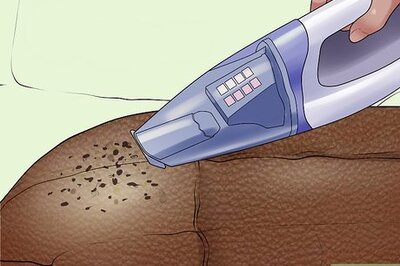
views
Washington: The nation's unemployment rate bolted to 8.1 per cent in February, the highest since late 1983, as cost-cutting employers slashed 651,000 jobs amid a deepening recession.
Both figures were worse than analysts expected and the Labor Department's report shows America's workers being clobbered by a wave of layoffs unlikely to ease in the coming months.
"There is no light at the end of the tunnel with these numbers," said Nigel Gault, economist at IHS Global Insight. "Job losses were everywhere and there's no hope for a turnaround any time soon."
February's net job loss came after even deeper payroll reductions in the prior two months, according to revised figures released Friday. The economy lost 681,000 jobs in December and another 655,000 in January.
Employers are shrinking their work forces and turning to other ways to slash costs — including trimming workers' hours, freezing wages or cutting pay — because the recession has eaten into their sales and profits. Customers at home and abroad are cutting back as other countries cope with their own economic problems.
Since the recession began in December 2007, the economy has lost 4.4 million jobs, more than half of which occurred in the past four months. President Barack Obama called that tally "astounding," but urged the American people to give him time to let his economic revival plans take root.
"This recovery plan won't turn our economy around or solve every problem," Obama said. "All of this takes time and it will take patience."
With employers showing no appetite to hire, the unemployment jumped half a percentage point from 7.6 percent in January. That was the highest since December 1983, when the jobless rate was 8.3 percent.
All told, the number of unemployed people climbed to 12.5 mn. In addition, the number of people forced to work part time for "economic reasons" rose by a sharp 787,000 to 8.6 million. That's people who would like to work full time but whose hours were cut back or were unable to find full-time work.
If part-time, discouraged workers and others are factored in, the unemployment rate would have been 14.8 percent in February, the highest on records dating to 1994.
The pain hit blue- and white-collar workers, those without a high-school diploma and those highly educated. The jobless rate for people with a bachelor's degree or higher jumped to 4.1 percent last month from 3.8 percent in January. That's the highest on records dating to 1992.
Meanwhile, the average work week in February stayed at 33.3 hours, matching the record low set in December.
More positive economic news came from the Federal Reserve, which reported that consumer borrowing increased at an annual rate of $1.76 bn in the first month of the year. Economists expected borrowing to decline at a rate of $5 billion.
Still, the small rise in January is unlikely to shake economists' views that borrowing will remain weak this year as consumers tighten their belts in the face of massive layoffs and the recession. Consumer spending accounts for about 70 percent of U.S. economic activity.
On Wall Street, stocks surrendered early gains as the severity of U.S. job losses began to register with investors. The Dow Jones industrial average dropped about 110 points in afternoon trading and broader indexes also fell.
Job losses were widespread last month.
PAGE_BREAK
Construction companies eliminated 104,000 jobs. Factories axed 168,000. Retailers cut nearly 40,000. Professional and business services got rid of 180,000, with 78,000 jobs lost at temporary-help agencies. Financial companies reduced payrolls by 44,000. Leisure and hospitality firms chopped 33,000 positions.
The few areas spared: education and health services, as well as government, which boosted employment last month.
Disappearing jobs and evaporating wealth from tanking home values, 401(k)s and other investments have forced consumers to retrench, driving companies to lay off workers. It's a vicious cycle in which all the economy's negative problems feed on each other, worsening the downward spiral.
A new wave of layoffs hit this week.
General Dynamics Corp. said Thursday it will lay off 1,200 workers due partly to plummeting sales of business and personal jets that forced it to cut production. Defense contractor Northrop Grumman Corp., and Tyco Electronics Ltd., which makes electronic components, undersea telecommunications systems and wireless equipment, also are trimming payrolls.
The country is getting bloodied by fallout from the housing, credit and financial crises_ the worst since the 1930s. And there's no easy fix for a quick turnaround, economists said.
Obama is counting on a multipronged assault to lift the country out of recession: a $787 billion stimulus package of increased federal spending and tax cuts; a revamped, multibillion-dollar bailout program for the nation's troubled banks; and a $75 billion effort to stem home foreclosures.
Even in the best-case scenario that the relief efforts work and the recession ends later in 2009, the unemployment rate is expected to keep climbing, hitting 9 percent or higher this year. In fact, the Federal Reserve thinks the unemployment rate will stay elevated into 2011. Economists say the job market may not get back to normal — meaning a 5 percent unemployment rate — until 2013.
Businesses won't be inclined to ramp up hiring until they are sure any economic recovery has staying power.
The economy contracted at a staggering 6.2 percent in the final three months of 2008, the worst showing in a quarter-century, and it will probably continue to shrink during the first six months of this year.
Given Friday's grim figures, Gault predicted the economy would probably shrink in the first quarter at a pace of at least 6 percent, and that the unemployment rate will rise as high as 10 percent in the first half of 2010.
Fed Chairman Ben Bernanke told Congress earlier this week that recent economic barometers "show little sign of improvement" and suggest that "labor market conditions may have worsened further in recent weeks."



















Comments
0 comment